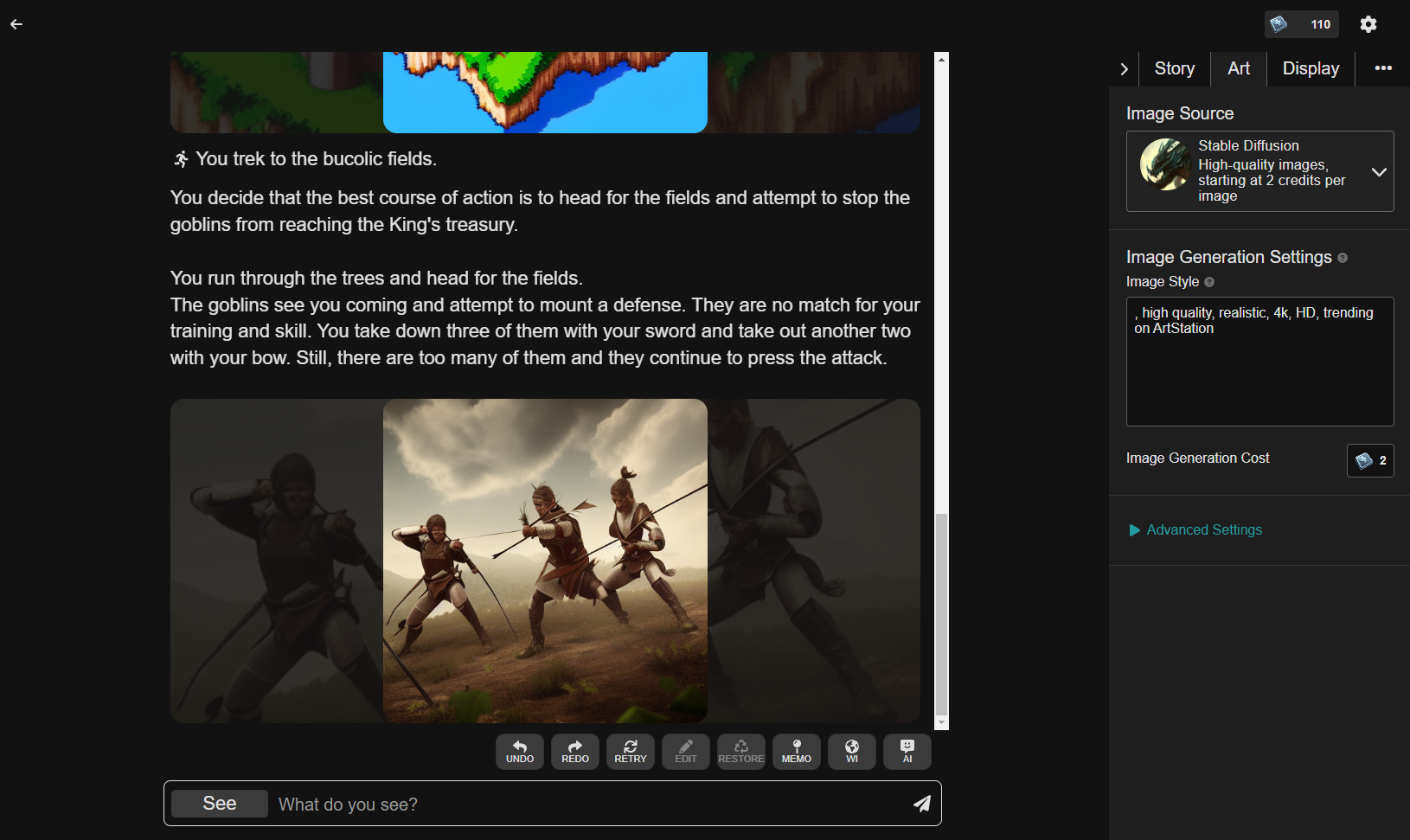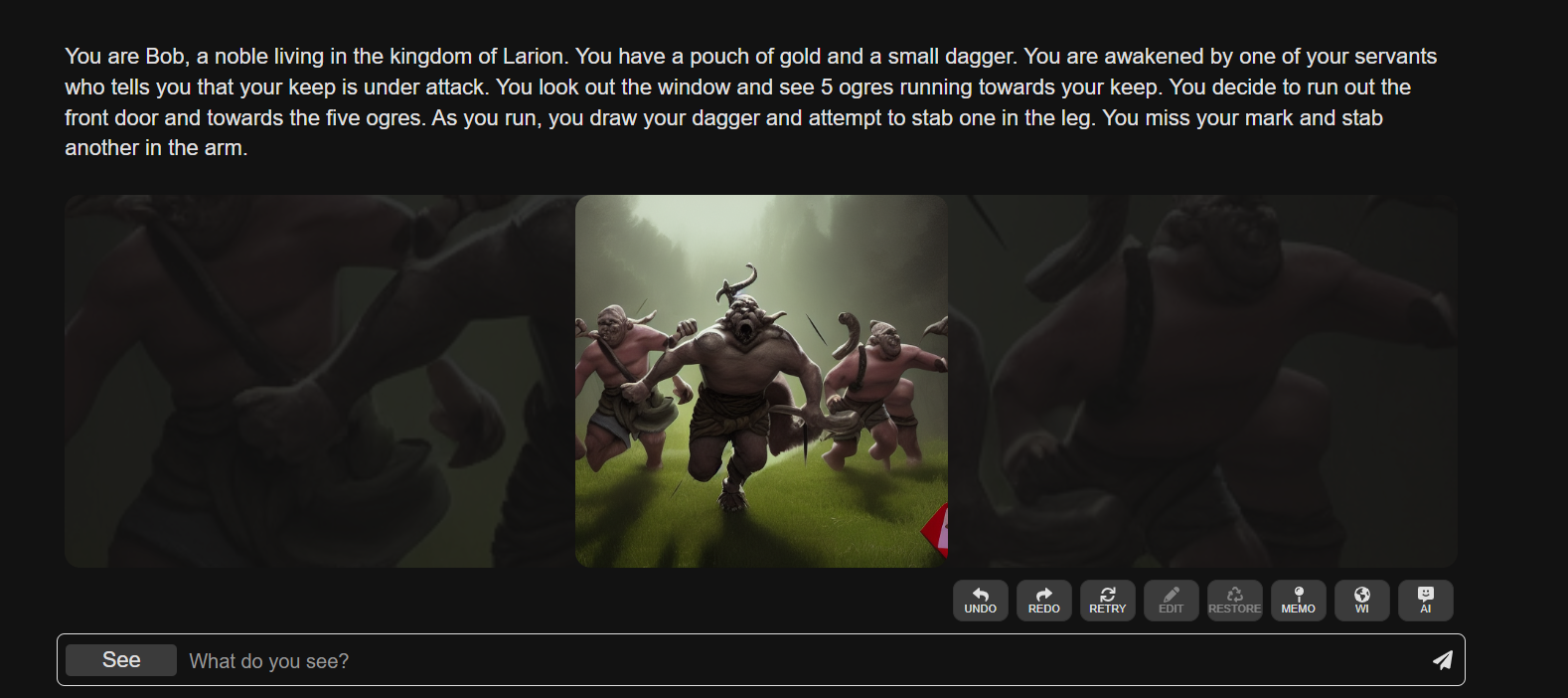AI Dungeon realized the dream many gamers have had since the ’80s: an evolving storyline that players themselves create and direct. Now, it’s going further with a new feature that enables players to generate images that illustrate those stories.
Developed by indie game studio Latitude, which was initially a one-person operation, AI Dungeon writes dialogue and scene descriptions using one of several text-generating AI models — allowing players to respond to events how they choose (within reason). It remains a work in progress, but with the emergence of image-generating systems like Stability AI’s Stable Diffusion, Latitude is investing in new ways to liven up players’ narratives.

Within the AI Dungeon UI, you can select a “See” option at any time to prompt Stable Diffusion to generate an illustration.
Access requires a subscription to one of Latitude’s premium plans, which starts at $9.99 per month. It’s a credit-based system — generating an image costs two credits, with credit limits ranging from 480 per month for the cheapest plan to 1,650 for the priciest ($29.99 per month). On the AI Dungeon client available through Valve’s Steam marketplace, which is priced at $30, members get 500 credits with their purchase.
“With Stable Diffusion, image generation is fast enough and cheap enough to offer custom image generation to everyone. Image generation is fun on its own, and being able to create custom images to go with your AI Dungeon story was a no brainer,” Latitude senior marketing director Josh Terranova told TechCrunch via email.
Unlike image-generating systems of a comparable fidelity (e.g., OpenAI’s DALL-E 2), Stable Diffusion is unrestricted in what it can create excepting the versions served through an API, like Stability AI’s. Trained on 12 billion images from the web, it’s been used to generate artwork, architectural concepts and photorealistic portraits — but also pornography and celebrity deepfakes.
Latitude hopes to lean into this freedom, allowing users to create “NSFW” images, including nudes, so long as they don’t make them public. AI Dungeon’s built-in story-sharing mechanism is currently disabled for stories containing images — a step Terranova says is necessary while Latitude “figure[s] out the right experience and safeguards.”

Image Credits: Latitude
That’s taking a big risk. Latitude landed in hot water several years ago when some users showed that the game could be used to generate text-based simulated child porn. The company implemented a moderation process involving a human moderator reading through stories alongside an automated filter, but the filter frequently flagged false positives, resulting in overzealous banning.
Latitude eventually corrected for the moderation process’ flaws and implemented an acceptable content policy — but not until after some serious review bombing and negative publicity. Eager to avoid the same fate, Terranova says that Latitude is taking steps to “sensibly” curate AI-generated images while affording players creative expression.
“We are working with Stability AI, the makers of Stable Diffusion, to ensure measures are in place to prevent generating certain types of content — mainly content depicting the sexual exploitation of children. These measures would apply to both published and unpublished stories,” Terranova said. “There are several unanswered questions about the use of AI images that all of us will be working through as AI image models become more accessible. As we learn more about how players will use this powerful technology, we expect adjustments could be made to our product and policies.”
In my limited experiments, the new Stable Diffusion-powered feature works — but not consistently well, at least not yet. The images generated by the system indeed reflect AI Dungeon’s imagined scenarios — e.g., a picture of a pirate in response to the prompt “You come across a captain” — but not in a similar art style, and sometimes with details omitted.

Image Credits: Latitude
For example, Stable Diffusion was confused by one scene particularly rich in detail: “You hide in the bushes. You spot a group of thugs, who are carrying a bundle of money. You leap out and stab one of the thugs, causing him to drop the bundle.” In response, AI Dungeon generated an image of a swordswoman in a forest against a backdrop of a city — so far so good — but without the “bundle of money” in sight.
Another complex scene involving skirmishing goblins gave Stable Diffusion trouble. The system seemed to focus on particular keywords at the expense of context, generating an image of warriors with bows instead of goblins pierced by a sword and arrows.
AI Dungeon lets you toggle the prompt to fine-tune the results, but it didn’t make a massive difference in my experience. Edits had to be incredibly specific to have much of an effect (e.g., adding a line like “in the style of H. R. Giger”), and even then, the impact wasn’t obvious beyond the color pallet. My hopes for a story illustrated entirely by pixel art were quickly dashed.
Still, even when the scene illustrations aren’t perfectly on-topic or realistic — think pirates with sausage-like fingers standing the middle of an ocean — there’s something about them that give AI Dungeon’s storylines greater weight. Perhaps it’s the emotional impact of seeing characters — your characters — brought to life in a sense, engaged in battling or bantering or whatever else makes its way into a prompt. Science has found as much.
What about the — ehem — less SFW side of Stable Diffusion and AI Dungeon? Well, that’s tough to say, because it’s nonfunctional at the moment. When this reporter tested a decidedly NSFW prompt in AI Dungeon, the system returned an error message: “Sorry but this image request has been blocked by Stability.AI (the image model provider). We will allow 18+ NSFW image generation as soon as Stability enables us to control this ourselves.”

Image Credits: AI Dungeon
“[The] API has always had the same NSFW classifier that the official open source release/codebase has in the default install,” Emad Mostaque, the CEO of Stability AI, told TechCrunch when contacted for clarification. “[It] will be upgraded soon to a better one.”
Terranova says that Latitude has plans to expand image generation with emerging AI systems, perhaps sidestepping these sorts of API-level restrictions.
With time, I think that’s an exciting future — assuming that the quality improves and objectionable content doesn’t become the norm on AI Dungeon. It previews a whole new category of game whose artwork is generated on the fly, tailored to adventures that players themselves dream up. Some game developers have already begun to experiment with this, using generative systems like Midjourney to spit out art for shooters and choose-your-own adventure games.
But those are big ifs. If the past few months are any indication, content moderation will prove to be a challenge — as will solving the technical issues that continue to trip up systems like Stable Diffusion.
Another open question is whether players will be willing to stomach the cost of fully illustrated storylines. The $10 subscription tier nets 250 illustrations or so, which isn’t much considering that some AI Dungeon stories can stretch on for pages and pages — and considering that crafty players could run the open source version of Stable Diffusion to generate artwork on their own machines.
In any case, Latitude is intent on charging full steam ahead. Time will tell whether that was wise.
Latitude brings AI-generated artwork to AI Dungeon by Kyle Wiggers originally published on TechCrunch
DUOS





